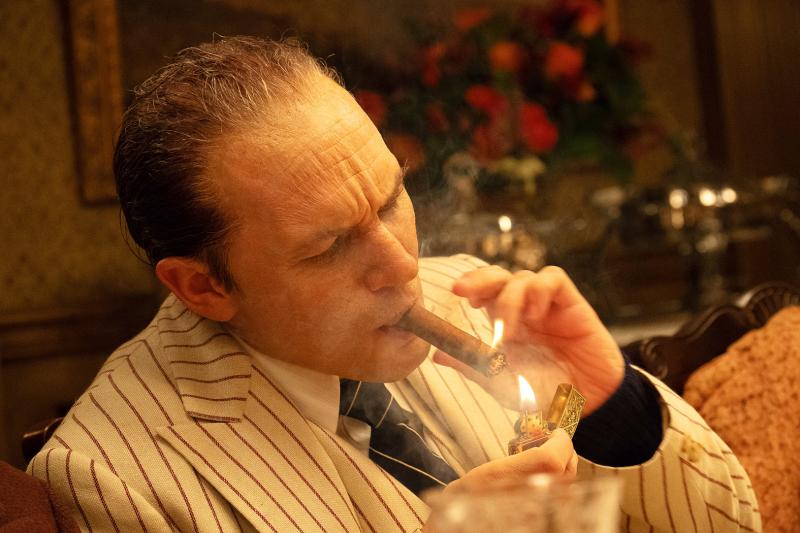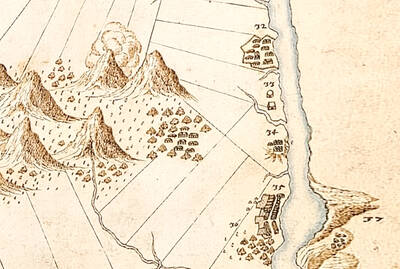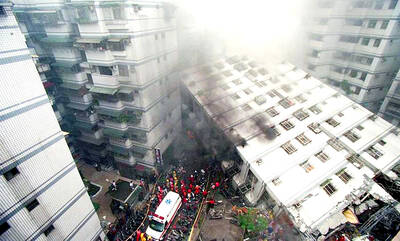Al Capone lived out his final years on a grand estate in Palm Island, Florida, with his wife, Mae, by his side and grandchildren running around the property. It sounds like a pretty nice end for the notorious Chicago gangster, until you realize that he spent those post Alcatraz years suffering from declining health, dementia and the long-term effects of a syphilis infection from when he was just a teenager that went untreated. Also? He was likely broke. Then he died of a heart attack on Jan. 25, 1947. He was only 48.
It’s this chapter that gets the focus in Capone, a hallucinatory and messy (in all respects) film starring Tom Hardy as the once great crime boss who is now hardly recognizable to himself or his family and in a state of rapid decline. With ashen skin, blood-red eyes and a voice that is so raspy as to be almost unintelligible, Hardy’s Capone looks like a drawing of a comic book gangster that’s gone too far.
“Fonse” (the name Al is not to be uttered on the property) totters around his well-groomed and cliche Floridian mansion in an open robe with a cigar (and, later, a carrot) hanging out of his mouth. When he’s not shouting at his wife (Linda Cardellini) or gardeners, he can often be found with a thousand-yard stare, which either means he’s about to go into a flashback sequence or is soiling himself — he does both quite frequently. His decay is cartoonish, as though all of his past sins are oozing out of his brain and body. They are laid out just as chaotically and unpleasantly in Capone for audiences to make sense of.

photo: AP
Capone is the work of filmmaker Josh Trank, who, you may recall, is the blockbuster wunderkind who became a bit of a pariah in under four years. His film Chronicle made him, at 27, a precious box office superstar who earned comparisons to Spielberg and Cameron. But his decline started before he could make good on the assumption that he was the next big thing. He was then hired, and fired, from a Star Wars film. But perhaps his most infamous moment was when he distanced himself from his expensive Fantastic Four reboot a day before it opened (and bombed) with a tweet implying that studio interference ruined his once great film.
Although we’ll never get to see what he might have done left to his own devices with Fantastic Four, for better or worse Capone is fully a Josh Trank product. He wrote, edited and directed. And although Capone has interesting elements and a strong style, it is also deeply flawed and a bit of a slog to get through.
Hardy’s go-for-broke performance is certainly jaw-dropping, but not exactly effective in drawing you in to care about his story or his regrets. There are threads that are introduced with little resolve: The possible US$10 million that he’s hidden and lost, the FBI agent (a compelling Jack Lowden) who has to convince his own boss that Capone is worth continuing to investigate and the out-of-wedlock son who keeps calling and appearing to him. The supporting cast is wasted (it’s not just Cardellini). Matt Dillon pops up for a bit. And Kyle MacLachlan plays the physician who suggests the family give him a carrot instead of a cigar, since he won’t notice anyway. It’s also numbingly violent.
Al Capone’s last year could make for an interesting film, but there is little poetry or transcendence in Capone, and nothing even remotely close to the quietly devastating third act of The Irishman. Although maybe Trank wanted something more garish and horrifying and surreal for Capone, like a carrot cigar, a droopy diaper and a golden Tommy Gun. At the very least, it’s hard to look away.

Last week gave us the droll little comedy of People’s Republic of China’s (PRC) consul general in Osaka posting a threat on X in response to Japanese Prime Minister Sanae Takaichi saying to the Diet that a Chinese attack on Taiwan may be an “existential threat” to Japan. That would allow Japanese Self Defence Forces to respond militarily. The PRC representative then said that if a “filthy neck sticks itself in uninvited, we will cut it off without a moment’s hesitation. Are you prepared for that?” This was widely, and probably deliberately, construed as a threat to behead Takaichi, though it

Nov. 17 to Nov. 23 When Kanori Ino surveyed Taipei’s Indigenous settlements in 1896, he found a culture that was fading. Although there was still a “clear line of distinction” between the Ketagalan people and the neighboring Han settlers that had been arriving over the previous 200 years, the former had largely adopted the customs and language of the latter. “Fortunately, some elders still remember their past customs and language. But if we do not hurry and record them now, future researchers will have nothing left but to weep amid the ruins of Indigenous settlements,” he wrote in the Journal of

Even after years in business, weekend tables here can be booked out a month in advance. The price point far exceeds its competitors. Granted, expectations are soaringly high, but something here failed to hit the high notes. There are a few telltale signs that a restaurant relies solely on outstanding food to create the experience, no gimmicks or distractions needed. La Mole is such a restaurant. The atmosphere is food-forward, with an open kitchen center stage. Our tables are simple; no candles, no dim lighting, no ambient music. The menu is brief, and our waiter directs most

If China attacks, will Taiwanese be willing to fight? Analysts of certain types obsess over questions like this, especially military analysts and those with an ax to grind as to whether Taiwan is worth defending, or should be cut loose to appease Beijing. Fellow columnist Michael Turton in “Notes from Central Taiwan: Willing to fight for the homeland” (Nov. 6, page 12) provides a superb analysis of this topic, how it is used and manipulated to political ends and what the underlying data shows. The problem is that most analysis is centered around polling data, which as Turton observes, “many of these